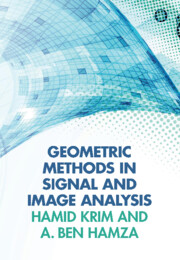4 - Differential geometry of curves and surfaces
Published online by Cambridge University Press: 05 July 2015
Summary
Differential geometry refers to the study of geometric properties using the basic tools of differential and integral calculus. Differentiation is primarily concerned with determining a given function's rate of change, while integration is essentially used to determine displacement. Differential geometry of curves and surfaces appears in a broad variety of engineering and computer science areas, including signal and image processing, computer vision, computer graphics, and computer-aided design [5,49–53]. In image processing, for example, geometric methods are used extensively in a bevy of imaging applications, particularly in image enhancement, segmentation, compression, watermarking, inpainting, and retrieval. Geometric signal processing, on the other hand, naturally applies the fundamental principles of signal processing on 3D surfaces or, more generally, on graphs with various applications ranging from 3D shape analysis and recognition to social networks, machine learning, and the smart grid. Designing curves and surfaces for computer-aided design applications is a major driving force for the automotive, aerospace, and architecture industries, and is also of paramount importance in delivering advanced visual effects not only in the film industry, but also in the fast-growing video game industry.
In this chapter, we begin our study of the local theory of curves and surfaces in the context of differential geometry. We focus primarily on studying the geometric properties of parametric curves and surfaces. In Section 4.1, we define and present through illustrative examples the essential geometric properties of plane curves as well as space curves. In particular, we define the tangent, speed, length, arc-length, curvature, and torsion of parametrized curves. We also present the Frenet–Serret apparatus, which essentially determines the local geometry of curves. Moreover, we briefly describe the fundamental theorem of curves, which basically states that a space curve is uniquely determined by its curvature and torsion up to a rigid motion. Section 4.2 is devoted to the basic concepts of local surface theory, including the tangent plane, vector fields, Gauss map, first and second fundamental forms, and surface curvatures. Finally, we present in Section 4.3 an application of differential geometry to image analysis.
Information
- Type
- Chapter
- Information
- Geometric Methods in Signal and Image Analysis , pp. 120 - 167Publisher: Cambridge University PressPrint publication year: 2015
